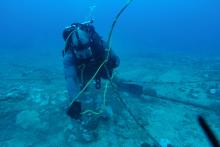The next step at McCarran will be to deploy self-service kiosks inside hotels on the Las Vegas strip. Passengers will be able to check in, print a boarding pass and bag tags, and give their baggage to handlers to take to the airport. These Windows 2000 units are the same as the CUSS systems in the airport, only they're connected to the airport over 56-Kbps WAN circuits. Off-site check-in would be impossible without common-use equipment, because hotels would never devote enough space for each airline to run its own terminal equipment, says David Bourgon, who as airline systems manager oversees the CUTE and CUSS systems at McCarran.
The Las Vegas Convention Center is scheduled to set up four to six self-service kiosks by July. Beyond that, McCarran must negotiate with hotels individually.
CUTE sounds like an idea whose time has come, but McCarran is a rarity among U.S. airports: Only 5 percent of a typical airline's gates are CUTE gates, says ACI's Marchi, so the carriers' IT organizations focus on developing and maintaining software for proprietary systems. Their developers prioritize writing code for the legacy systems before they worry about how those changes will affect the presentation of their applications on CUTE front ends. "CUTE is an afterthought," Marchi says, so the CUTE code tends to be buggy.
But one major obstacle to CUTE adoption is about to be lifted. When the airlines built their terminal buildings in the 1960s and '70s, they signed 30- or 40-year leases with local governments. Those leases are coming due, and Marchi thinks most municipalities will decide to run the terminals themselves, as Clark County does at McCarran. Many will want to push common-use equipment to exert control, Marchi says.
The exceptions will be airports where one carrier operates a transfer hub. For example, at Hartsfield Atlanta International Airport, where Delta Air Lines controls 75 percent of the volume, it doesn't make sense to deploy CUTE throughout the airport if other airlines will never use Delta's gates. In those airports, a hybrid approach may emerge, with a portion of the airport employing CUTE for carriers that don't need dedicated gates.
Meantime, the airlines are under more financial pressure than ever as businesses and consumers cut back on travel amid a weak economy and fears of terrorism. The airlines are looking to outsource as much as they can, Marchi says. "If a ticket printer breaks at most airports, Delta has to fly someone in to fix it," he says. "At McCarran, they have the spare parts and the technician on site, and they just repair it for the airline." A printer problem is usually resolved in about 30 minutes, Bourgon says. McCarran doesn't charge the airlines separately for service calls.








